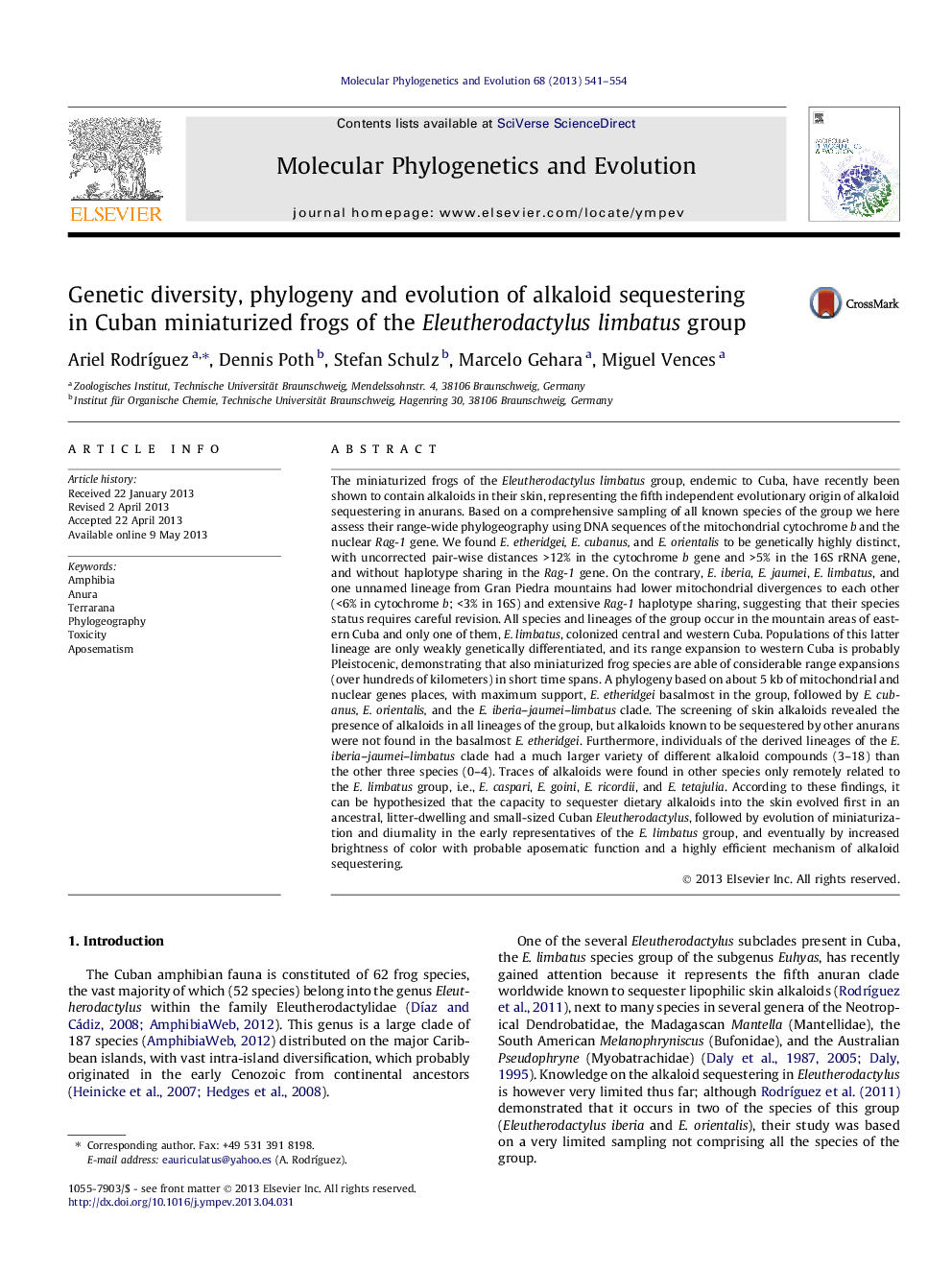| کد مقاله | کد نشریه | سال انتشار | مقاله انگلیسی | نسخه تمام متن |
|---|---|---|---|---|
| 5919794 | 1164272 | 2013 | 14 صفحه PDF | دانلود رایگان |

- A comprehensive analysis of genetic variation using mitochondrial and nuclear markers.
- Three species could be reliable delimited but the taxonomic status of E. iberia, E. jaumei, and E. limbatus is questioned.
- The group originated in eastern Cuba and only one of the main lineages expanded to the west in the Pleistocene.
- Skin alkaloids were detected in all lineages of the group.
- Alkaloid sequestration evolved first and was followed by miniaturization, diurnality and contrasting coloration.
The miniaturized frogs of the Eleutherodactylus limbatus group, endemic to Cuba, have recently been shown to contain alkaloids in their skin, representing the fifth independent evolutionary origin of alkaloid sequestering in anurans. Based on a comprehensive sampling of all known species of the group we here assess their range-wide phylogeography using DNA sequences of the mitochondrial cytochrome b and the nuclear Rag-1 gene. We found E. etheridgei, E. cubanus, and E. orientalis to be genetically highly distinct, with uncorrected pair-wise distances >12% in the cytochrome b gene and >5% in the 16S rRNA gene, and without haplotype sharing in the Rag-1 gene. On the contrary, E. iberia, E. jaumei, E. limbatus, and one unnamed lineage from Gran Piedra mountains had lower mitochondrial divergences to each other (<6% in cytochrome b; <3% in 16S) and extensive Rag-1 haplotype sharing, suggesting that their species status requires careful revision. All species and lineages of the group occur in the mountain areas of eastern Cuba and only one of them, E. limbatus, colonized central and western Cuba. Populations of this latter lineage are only weakly genetically differentiated, and its range expansion to western Cuba is probably Pleistocenic, demonstrating that also miniaturized frog species are able of considerable range expansions (over hundreds of kilometers) in short time spans. A phylogeny based on about 5Â kb of mitochondrial and nuclear genes places, with maximum support, E. etheridgei basalmost in the group, followed by E. cubanus, E. orientalis, and the E. iberia-jaumei-limbatus clade. The screening of skin alkaloids revealed the presence of alkaloids in all lineages of the group, but alkaloids known to be sequestered by other anurans were not found in the basalmost E. etheridgei. Furthermore, individuals of the derived lineages of the E. iberia-jaumei-limbatus clade had a much larger variety of different alkaloid compounds (3-18) than the other three species (0-4). Traces of alkaloids were found in other species only remotely related to the E. limbatus group, i.e., E. caspari, E. goini, E. ricordii, and E. tetajulia. According to these findings, it can be hypothesized that the capacity to sequester dietary alkaloids into the skin evolved first in an ancestral, litter-dwelling and small-sized Cuban Eleutherodactylus, followed by evolution of miniaturization and diurnality in the early representatives of the E. limbatus group, and eventually by increased brightness of color with probable aposematic function and a highly efficient mechanism of alkaloid sequestering.
Journal: Molecular Phylogenetics and Evolution - Volume 68, Issue 3, September 2013, Pages 541-554